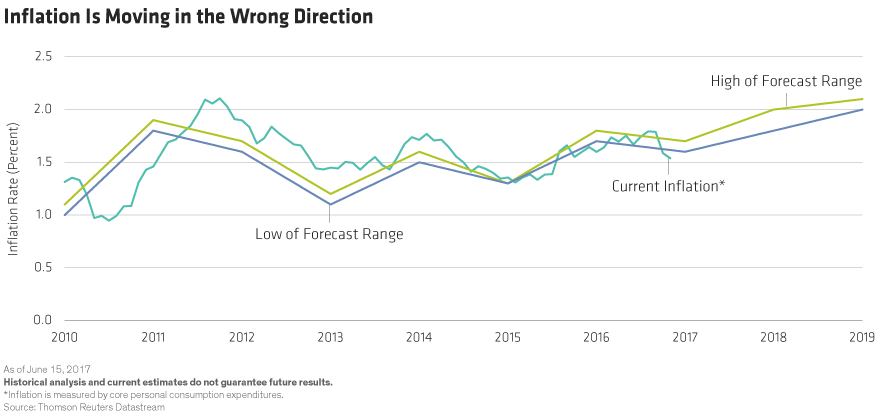The Fed’s rate hike Wednesday was thoroughly unsurprising. But under the surface calm, policymakers are wrestling with a dilemma in the US economy that will be a major influence on policy ahead.
The Fed’s basic model of the economy involves a trade-off between unemployment and inflation. If the labor market is tight—in other words, if unemployment is below the economy’s “natural” rate of unemployment—inflation should rise. Policy decisions flow naturally from this trade-off. If unemployment is low and inflation is rising, raising interest rates is a straightforward decision.
But that’s not the case right now: both unemployment and inflation are too low.
At 4.3%, the unemployment rate is below the Fed’s estimate of the natural unemployment rate, and the latest consumer price index (CPI) release was the third straight showing that inflation is slowing down, not picking up. At roughly 1.5%, the Fed’s preferred measure of inflation (core personal consumption expenditures) is well below the 2% target and moving the wrong way (Display).

How can both unemployment and inflation be falling, and what does it mean for monetary policy? There are no simple answers, but there are several possible explanations:
Exaggerated Labor Strength: The unemployment rate could be painting a too-rosy picture of how strong the labor market is. Maybe there are more workers available to work who simply haven’t rejoined the labor force but still might. This would imply that firms haven’t had to raise pay by enough to drive inflation. There’s some evidence of this: underemployment, which captures part-time workers who would rather work full time, is still somewhat above precrisis levels.
Temporary Inflation Influences: The inflation rate might be under downward pressure from temporary factors. For example, the recent proliferation of unlimited data cell phone plans has pulled inflation for communication services lower in the last three months. Once that adjustment is complete, it may stop holding back the overall economy’s inflation rate.
Growth Disappointment: The echo from disappointing first-quarter economic growth could be causing the inflation shortfall. Firms that are disappointed at the volume of their sales may have cut prices, particularly in department stores where there’s been heavy competition from online retailing.
Weakening Growth-Inflation Tradeoff: This explanation for the sluggish inflation rate is more worrying. It’s possible that the trade-off between growth and inflation just isn’t as powerful a relationship as it used to be. This is most concerning to the Fed—if it’s true, officials would have to do a major rethink of how they conduct monetary policy.
There just aren’t clear answers right now. There’s some evidence to support each explanation, and it may be that several of them are working together.
Where Does the Fed Go from Here?
Given the lack of clarity, it’s harder to predict the path of monetary policy today than in the past few months. With both unemployment and inflation undershooting the Fed’s objectives, the response function is uncertain.
For now, the Fed still seems to be putting more weight on the decline in the unemployment rate, and seems to believe that temporary influences are the culprit. So, based on the committee’s updated forecasts and Fed Chair Janet Yellen’s comments, Fed officials seem likely to continue with rate hikes. It’s hard to blame them—the last couple of rate hikes haven’t tightened financial conditions at all, so there’s been no apparent real cost to raising rates. If that’s true and rate hikes have the potential to stabilize the medium-term outlook, it seems prudent to expect more hikes.
That’s our general expectation. Our base-case scenario is for one more rate hike in 2017 along with the beginning of balance-sheet normalization. But we’re not as firm on that base case than we have been—if inflation doesn’t start to perk up in the next couple of months, we’ll have to change our view.
The views expressed herein do not constitute research, investment advice or trade recommendations and do not necessarily represent the views of all AB portfolio-management teams.